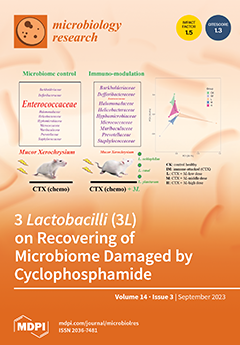The increased emergence of multidrug-resistant
Helicobacter pylori is related to many health issues.
Zingiber officinale (
Z. officinale) is a plant usually used in folk medicine to treat a variety of diseases. This study was conducted to evaluate the ability of
Z. officinale extract to combat resistant
H. pylori. The disc diffusion, microdilution, and microplate assays were performed to evaluate the susceptibility to antibiotics and the antibacterial and antibiofilm activities of the
Z. officinale extracts. Using the checkerboard method, the combined effects of gentamicin and
Z. officinale extract were investigated. In addition, anti-inflammatory activity and GC-MS analysis were performed according to a modified protocol. According to the findings,
H. pylori isolates exhibited resistance rates of 56.33, 50.0, and 45.85 against metronidazole, gentamicin, and tetracycline, respectively. The methanolic extract of
Z. officinale showed the strongest effectiveness against resistant
H. pylori isolates with MICs of 20.0 to 50.0 µg/mL, including both
H. pylori isolates and the standard strain NCTC 11637.
Z. officinale extract suppresses the biofilm formed by
H. pylori isolates with a percentage of 92.96% at 50.0 µg/mL, compared with 97.19% for gentamicin at the same concentration. According to FICI values, the combination of methanolic
Z. officinale extract with gentamicin increases bacterial sensitivity to such drugs. Moreover, the
Z. officinale extract exhibits strong anti-inflammatory activity, with inhibition of red blood cell membrane stabilization increasing from 49.83% to 61.47% at a concentration of 4 to 32 µg/mL. The GC-MS analysis of
Z. officinale extract exhibits 17 different chemical compounds. Besides showing antibacterial properties, the extract also contains the anti-inflammatory compound gingerol as the main constituent, which inhibits the growth of
H. pylori and its biofilm and is a promising natural therapeutic alternative or enhances antibiotic activity.
Full article





